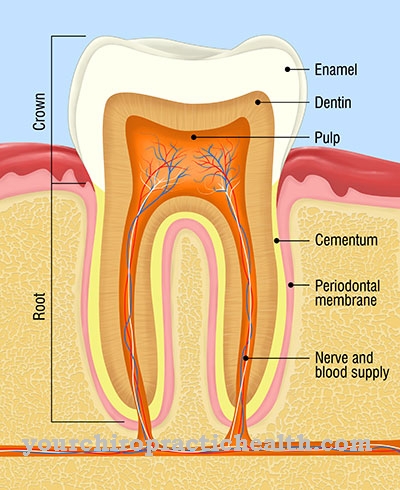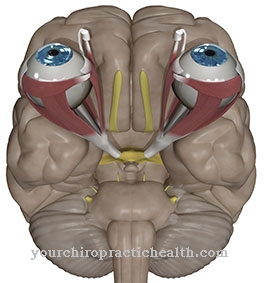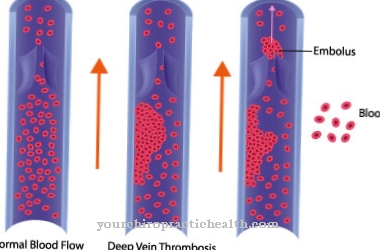A intracerebral haemorrhage (ICB or IZB) represents a hemorrhage within the brain tissue. This is a hemorrhagic stroke, which manifests itself by symptoms similar to an ischemic stroke. The prognosis for this bleeding depends on its location in the brain, its severity and the start and course of medical treatment.
What is intracerebral hemorrhage?

© maniki - stock.adobe.com
About 15 percent of all strokes are caused by bleeding into the brain tissue (hemorrhagic stroke). The remaining 85 percent are the result of reduced blood flow in certain areas of the brain. In both cases, brain tissue dies.
The symptoms and the course of hemorrhagic stroke depend on the region of their occurrence in the brain and the severity of the bleeding. Furthermore, the correct therapy and the time at which emergency measures are started are also decisive for the chances of recovery. Cerebral haemorrhage usually occurs when small arterial blood vessels burst. A intracerebral haemorrhage but can also be caused by an injury to venous blood vessels.
The causes are varied. Diseases of blood vessels, coagulation disorders, the use of anticoagulants, vascular malformations and much more play a role. Around one million hemorrhagic strokes are observed worldwide. This affects around 90,000 people in the European Union. However, there are strong regional differences that may be explained by special environmental conditions, lifestyles or genetic predispositions.
causes
The most important cause of intracerebral bleeding is arterial high blood pressure. This risk factor was found in 70 to 80 percent of all people with hemorrhagic stroke. Furthermore, the risk is also increased when taking anticoagulant medication.
In the preventive treatment of leg vein thrombosis, heart attacks or ischemic sleep attacks with anticoagulants, there is even an 11-fold risk of cerebral hemorrhage. In addition, the administration of acetylsalicylic acid after heart attacks or ischemic strokes increases the risk of cerebral haemorrhage.
This becomes particularly clear when combining several anticoagulant preparations. The same goes for people with bleeding disorders. Blood vessel disorders can also play a role in the etiology of intracerebral hemorrhage.
Arterial diseases include acquired and genetic changes in small arterial blood vessels, amyloid angiopathy, cerebral aneurysm, vasculitis, moyamoya, and other diseases of the large arteries. Vascular malformations can also trigger cerebral hemorrhage.
Cerebral hemorrhages are also possible through brain metastases. Sometimes the cause cannot be identified. These cases are idiopathic or cryptic intracerebral bleeding. Overall, alcohol consumption and smoking have been found to increase the risk of bleeding in the brain.
Symptoms, ailments & signs
The symptoms of intracerebral bleeding (hemorrhagic stroke) are similar to those of ischemic stroke. In both cases, certain areas of the brain die off. However, the symptoms and the course of the stroke depend on the affected brain region and the strength of the dead area.
Headache, nausea, vomiting, paralysis of the legs, arms or face on one side, numbness, speech, vision or swallowing disorders as well as dizziness, impaired consciousness and even epileptic seizures occur in different degrees. It was found that the risk of an epileptic seizure is significantly greater with a hemorrhagic stroke than with an ischemic stroke.
An epileptic seizure is particularly common within 24 hours of the cerebral hemorrhage. In one third of the patients with intracerebral hemorrhage, the EEG showed typical epileptic potentials without the need for an epileptic seizure. A hemorrhagic stroke can also lead to psychological changes, which manifest themselves, for example, in sudden changes in feeling and behavior as well as confusion and even coma.
Diagnosis & course of disease
A cerebral hemorrhage can be reliably detected by a computed tomography of the skull and differentiated from a hemorrhagic stroke by differential diagnosis. Alternatively, an MRI examination is also possible.
Complications
In most cases, this bleeding kills certain areas of the brain. The further course of the disease depends heavily on the affected region and the duration of this bleeding. The patients often suffer from very severe headaches, vomiting and nausea. Paralysis also occurs in different regions of the body, so that the affected person may not be able to move his arms and legs.
As a result, it is not uncommon for severe movement restrictions and, furthermore, to also lead to considerable restrictions in the patient's everyday life. As the bleeding progresses, the patient may also have an epileptic seizure. The quality of life of the person affected is significantly reduced and restricted. Not infrequently, the damage in the brain also has a negative effect on the actions and thinking of the person concerned, so that confusion or even a coma can occur.
Relatives can also suffer psychologically from the situation. This bleeding is treated by an emergency doctor. Possible consequential damage can be limited. In most cases, however, the patient's life expectancy is reduced.
When should you go to the doctor?
People who have repeated headaches, nausea, vomiting, and dizziness should consult a doctor. If the symptoms increase in intensity, medical help is required. If there are disturbances in attention, concentration or memory, this is worrying and must be clarified medically. A doctor is required in the event of speech problems, interruptions in communication, difficulty swallowing and various functional disorders. Interruptions in seeing, hearing or other sensory modalities should be examined and treated.
In the event of sensory disturbances, numbness or paralysis, a doctor's visit is advisable as soon as possible. If there is a clouding of consciousness or loss of consciousness, an emergency doctor must be called. In the event of epileptic seizures, disorientation or interruptions in breathing, an ambulance service must be alerted. Until it arrives, first aid measures must be taken.
There is a life-threatening condition that requires intensive medical care. In the case of behavioral problems or changes in personality, there are brain changes that must be treated and diagnosed immediately by a doctor. Sudden and unexpected abnormalities are a special warning in the case of intracerebral hemorrhage. Immediate action and the consultation of a doctor are necessary to ensure the survival of the person concerned. In many cases, the affected person can no longer move their limbs and hardly reacts to questions asked.
Treatment & Therapy
The ICB is an emergency that needs to be dealt with as soon as possible. The patient is admitted to a neurological or neurosurgical intensive care unit for treatment. The first step is usually to lower the arterial blood pressure to stop the bleeding.
However, lowering blood pressure is controversial because it could lead to reduced blood flow in the region of intracerebral bleeding. In the majority of cases, however, lowering blood pressure has proven beneficial. Furthermore, this should be reduced if the body temperature is increased. Too high a body temperature has an adverse effect on the course of the disease.
In some cases, neurosurgical treatment is also performed. This depends on the cause of the bleeding, its location and the course. If the bleeding occurs in the area of the cerebrum, surgical treatment is only performed in exceptional cases. This consists, among other things, of hematoma evacuation in the event of a serious deterioration in consciousness.
If the bleeding is localized infratentorial in the area of the cerebellum, relief surgery often helps if the condition worsens. If the EEG examination reveals typical potentials for epilepsy, therapy with anticonvulsants should be given to prevent epileptic seizures.
Outlook & forecast
The prognosis for intracerebral bleeding depends on the location of the irregularities. The severity of the bleeding and the course of the disease are also decisive. In severe cases and without medical care, the person concerned threatens to die prematurely. Many die from a stroke or heart attack. Intensive medical treatment is normally necessary to ensure the patient's survival. The sooner medical care takes place, the greater the chances of survival. In addition, the permanent impairments and disturbances are reduced.
In many cases, long-term health irregularities occur despite rapid and professional therapy.Familiar obligations in everyday life can no longer be carried out as usual and without help. General dysfunction as well as a loss of physical and mental performance occur. They lead to a reduced quality of life and can trigger secondary diseases. In particular, the psychological resilience of the patient and the relatives increases and can trigger further diseases.
Numerous therapies are necessary in order to gradually improve the general state of health. Freedom from symptoms is not documented. The younger a patient, the faster intensive care treatment takes place and the fewer complications there are, the better the prognosis. In addition, the general health of the person concerned must be taken into account.
prevention
The most important thing you can do to prevent intracerebral bleeding is to prevent high blood pressure. This can be achieved through a healthy lifestyle with a balanced diet, plenty of exercise and abstaining from alcohol and smoking. If the blood pressure is already chronically elevated, not only should you change your lifestyle, but also lower your blood pressure with medication.
Aftercare
After the acute treatment of intracerebral bleeding, follow-up care begins. This continues the rehabilitation measures that have already been initiated. Depending on the individual situation, patients can not only take part in physiotherapy and occupational therapy measures, but also take advantage of speech therapy and neuropsychological care.
Prophylaxis against high blood pressure is particularly important in order to prevent the disease from recurring. This includes a balanced lifestyle. Eating healthy, getting enough exercise and not smoking or drinking will minimize the risk. If blood pressure is chronically high, people may also take drugs to lower blood pressure. The attending physician will prescribe these.
After the actual treatment, the patient is first given a rest phase to take it easy. During this time you shouldn't put too much strain on your body and shouldn't do sports. Psychological stress can also have a negative effect and should therefore be avoided. Regular medical examinations are mandatory for good control.
Any complications are noticed immediately and the doctor can intervene in good time. Depending on the severity of the disease, psychological therapy can be useful. As part of such treatment or in a self-help group, those affected learn to get used to their situation. You should not do without this professional and social support.
You can do that yourself
An intracerebral hemorrhage is a medical emergency that needs to be treated immediately. The first aiders must provide first aid and immediately bring the person affected to the nearest hospital or call in the emergency services.
After the treatment in the clinic, the patient needs rest and protection. It is advisable not to do any sport for a few days and also to avoid mental stress. In addition, regular check-ups by the doctor are indicated. This can ensure that the disease does not result in serious complications. Should any unusual symptoms arise, the responsible doctor must be informed. Sometimes the person concerned needs psychological treatment. Talking to a therapist is especially useful if you have severe bleeding that resulted in a panic attack. The chronically ill should also seek professional support and, if necessary, visit a self-help group.
Conservative remedies such as good wound care, cooling and protection can help with hematomas. With belladonna and arnica, homeopathy offers two effective preparations that relieve swelling and reduce pain. The use of these agents should first be discussed with the doctor.













.jpg)

.jpg)
.jpg)











.jpg)